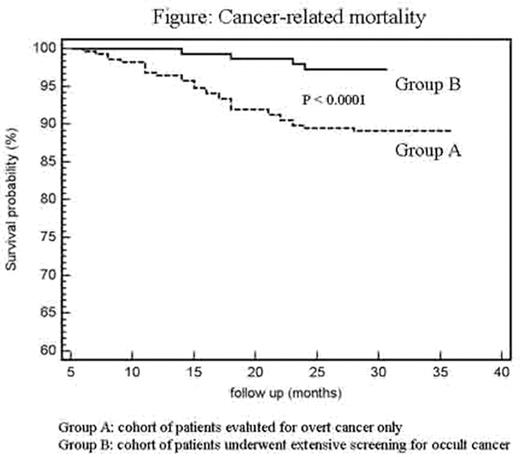Abstract
Background. Clinical advantages of extensive screening for occult cancer in patients with idiopathic Deep Vein Thrombosis (DVT) is still debated since this approach improves early detection of cancer but not cancer-related mortality. Recently, we have demonstrated that patients with Residual Vein Thrombosis (RVT), 3 months after DVT, have a high risk for cancer in the subsequent 2 years (
Objective of the study. We conducted a prospective study evaluating whether a RVT-based screening for cancer is sensitive and influences cancer-related mortality.
Study design. Prospective with two cohorts of DVT patients: the first cohort was monitored for clinical overt cancer only (Group A), while the second (Group B) received complete screening for occult neoplasm and subsequent surveillance.
Materials and methods. Consecutive patients with a first episode of DVT who presented RVT after 3 month of anticoagulation and without signs and/or symptoms for overt cancer. Screening for occult cancer was based on: ultrasound and/or CT scan of the abdomen and pelvis, gastroscopy, colonoscopy or sigmoidoscopy, hemoccult, sputum cytology and tumor markers. These tests were extended with mammography and Pap smear for women and ultrasound of the prostate and total specific prostatic antigen (PSA) for men. All investigations had to be completed within four-weeks from the assessment of RVT. All patients were followed-up for at least 2 years. Incidence and cancer-related mortality was compared between the two groups by survival curves (Kaplan-Mayer) and related Breslow test for statistics.
Results. Over a period of 6 years, 345 patients were included in the analysis: first cohort included 213 patients (Group A), second cohort 132 (Group B). Clinical characteristics between groups were homogenous. During the follow-up, 8.4% of patients developed overt cancer in group A; in group B, 8.3% of patients had diagnosed cancer at the moment of extensive screening while one new case (0.7%) occurred during the follow-up (Table). The sensitivity of this approach was 91.6% (95% confidence intervals 74.7–108.5). Cancer-related mortality was 6.5% in group A and 3.0% in group B (p< 0.001) (Figure).
Conclusions. Our study demonstrates that RVT-based screening for occult cancer improves early detection as well as cancer-related mortality.
Cancer events during surveillance
| Characteristic . | Group A (n= 213) . | Group B (N= 132) . |
|---|---|---|
| *4+0.5 months. **At least 24 months | ||
| Cancer, No (%) at screening time* | - - | **10 (8.3) |
| Cancer, No (%) during clinical surveillance** | 18 (8.4) | 1 (0.7) |
| Density incidence (cases x 1000 p/y) | 41.9 | 40.3 |
| Mean time cancer diagnosis (months ±SD) | 6.9 (1.3) | 3.6 (0.7) |
| Cancer-related mortality, No (%) | 14 (6.5) | 4 (3.0) |
| Cancer-related mortality, mean time (months ±SD) | 19 (3.4) | 18 (2.8) |
| Characteristic . | Group A (n= 213) . | Group B (N= 132) . |
|---|---|---|
| *4+0.5 months. **At least 24 months | ||
| Cancer, No (%) at screening time* | - - | **10 (8.3) |
| Cancer, No (%) during clinical surveillance** | 18 (8.4) | 1 (0.7) |
| Density incidence (cases x 1000 p/y) | 41.9 | 40.3 |
| Mean time cancer diagnosis (months ±SD) | 6.9 (1.3) | 3.6 (0.7) |
| Cancer-related mortality, No (%) | 14 (6.5) | 4 (3.0) |
| Cancer-related mortality, mean time (months ±SD) | 19 (3.4) | 18 (2.8) |
Figure: Cancer - related mortality
Author notes
Disclosure: No relevant conflicts of interest to declare.


